Marie Claude Quignon
the glasshouse
Writtle College, Essex, May 2003
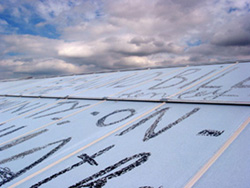
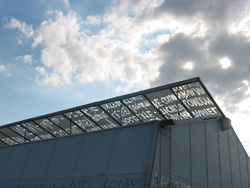
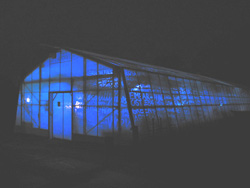
For over a hundred years students and staff at Writtle College have been considering how we interact with our environment and how that environment needs to be managed for aesthetic, leisure and productive purposes. The campus consists of a 220 hectare estate and students spend much of their time outdoors. For this arts exchange a medium span alloy glass-house used in the production of ornamental plants for the gardens was the inspiration for a community-based work by the French artist Marie Claude Quignon. The project, undertaken as part of an exchange programme between Picardy and Essex, sought to investigate the diversity of the community at Writtle.
On her first visit to the College Marie Claude noticed a small piece of graffiti scratched on the white-painted surface of a glasshouse. Following a conversation between the artist and a member of staff, a questionnaire was drawn up. This was used to generate words which would express a collective consciousness of college life. Respondents were asked to give their name, the town of their birth and five words which expressed their experience of Writtle - 117 responses, 819 words, 280 students and staff were involved in the project, about 12% of the College community. The words were compiled by Marie Claude and with the help of students and staff inscribed on the outside of a glasshouse which had been covered with horticultural whitewash normally used to protect plants from strong sunlight.
The finale of the work was an evening when the glasshouse was lit from within by an intense blue light, causing the words to glow. This blue light was achieved by covering the glasshouse and additional lighting with deep blue photographic gel, while a radio was set to the classical station preferred by Peter, the gardener. Some of the words may have seemed obscure to the viewer. For example, “chocolate” was supplied by a part-time student who only allowed herself this treat on the days she attended college. “Scurf”, a disease of potatoes, was supplied by a student who had been researching it for his doctorate.
In the future, a detailed analysis will be carried out on the words. The process was documented in the form of a video by Marie Claude and as a workbook showing the development of the work.
Previous Work
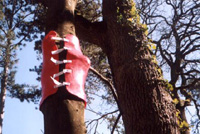
Tous les arbres sont remarquables,
Œuvre in-situ, 2003
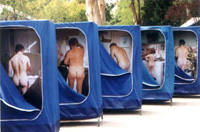
Camping folies, 1999
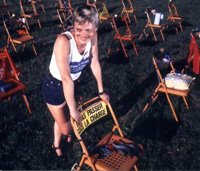
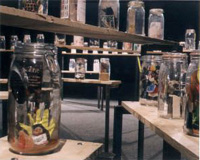
1001 Bocaux l’Art sur
la Place, 2000